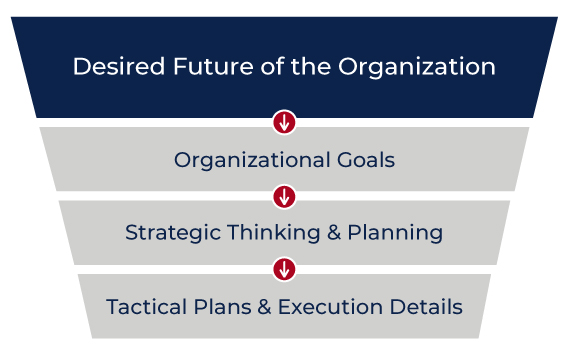Strategy and tactics – what’s the difference? Many people assume that goals and strategic thinking are the same as tactical planning and will use the terms interchangeably. However, the concept of strategy is very different than the concept of tactics. As a student pursuing a Master of Information Systems Management degree, you’ll gain a better understanding of these concepts and prepare for an advanced career in the field of IT.
Defining the Terms
Before we dive into how these terms will impact you as you move forward in your career, first let’s take a look at the concepts and see how they flow through the funnel, from broad to specific in nature.

Goals: Goals are the outcomes desired by an organization, which is usually a long-term future target or market position.
Strategy: This term describes the art of creating plans aimed at attaining an overall set of objectives to meet the organizational goals. The objectives have broad, guiding statements and little detail for accomplishing the goals. Strategy does not include timelines or execution details.
Tactics: Tactics are methods, modes, procedures, or maneuvers planned or used toward attaining an objective within a strategy. Tactical plans contain detailed information on the projects, tasks, processes, people, and resources required to meet an objective. Tactical plans include timelines and execution details.
Simply stated, goals are created, objectives are identified through strategic thinking, and then tactical plans are developed. From the tactical planning, the details for individual projects are identified, scoped, and project execution plans developed.
As you can see, the terms strategy and tactics are quite different. They have different approaches to the conceptual thinking as well as to the planning associated with each.
Understanding the Importance
As you grow through your technical career, most of what you do is comprised of tactical thinking and planning, and of course, execution.
For example, in the early part of your career, you are charged with getting things done – you’re the doer of projects, the tracker of data, the creator of reports, the maker of things, the designer of products, and so on. You’re responsible for figuring out the steps, tasks, and paths for getting these things done to meet your assigned objectives. In other words, you are charged with the execution of someone else's strategy.
When technical people arrive in the lofty and rarefied levels of senior and executive management, their tried and true, very successful approach of tactical thinking is not what is needed at these levels. You are suddenly faced with the need to think strategically, and throughout your successful, tactically-oriented career, you likely haven't had much practice in thinking strategically. This truth is especially highlighted for those in IT and other technical fields where your honed abilities with tactical planning and execution have been the key to your success.
At the executive level, it's more about why things are done and much less about the details of the how and who is getting it done. Strategy is concerned with successfully attaining the objective, not the details of how it’s actually accomplished. And, as you might imagine, there is also a much greater focus on the human elements, which is essential to the strategic thinking style, too.
Some examples include recognizing and understanding the human factors aspect of the organizational culture, anticipating how the changes will affect employee morale, and what human issues are likely to arise as organizational/technological changes are implemented. These are just a few of the human and organizational elements that senior leaders must focus on in their positions.
Notice, too, that addressing many of these enterprise-wide, people-oriented issues aren’t what most technical people have had much experience with during their careers. Senior IT leadership has more to do with people than it does with the technical things in IT.
Learning the Skill
As an IT professional, you are a successful and respected technical person who has a track record of successfully executing projects and leading top performing technical teams. You’ve proven your competence with technology, have gained a variety of skills, and have an ability to deliver. In short, your expertise has enabled you to rise to this point in your career.
Now, you are pursuing that next step in your career path and are targeting a position in senior IT leadership. However, the technical credentials, skills, and abilities that have served you so well in the past will take a backseat to many of the skills needed for the challenges you will face as a senior IT leader. You will find that your focus has shifted away from just the ‘things in IT’ to paying attention to the whole organization, especially the people who are impacted by changing technology.
A Master of Information Systems Management will help you understand the wider organizational concerns facing IT leaders. Courses in the degree program will give you opportunities to work with common business scenarios faced by IT leaders where you can learn to develop strategic plans. Common scenarios such as enterprise-wide technology implementations and changes, business process re-engineering (BPR), and mergers and acquisitions provide foundations for developing and exercising strategic thinking and planning. These scenarios will include the all-important emotional intelligence elements and human aspects required for thinking strategically.
These are some of the key aspects that the Master of Information Systems Management degree program at the University of Arizona Global Campus addresses to help you explore and practice. Strategic thinking is different from tactical planning, and both are vitally important elements you will learn in this program that will prepare you for your future success as an IT leader.
--
By Dr. Steph YoungGonzaga, former assistant professor at UAGC.
